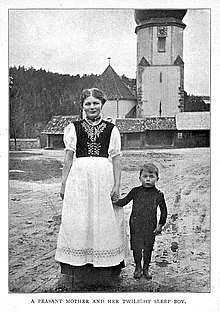Twilight sleep
Twilight sleep (English translation of the German word Dämmerschlaf[1][2]) is an amnesic condition characterized by insensitivity to pain without loss of consciousness, induced by an injection of morphine and scopolamine, especially to relieve the pain of childbirth.[3]

In 1899, a Dr. Schneiderlin recommended the use of hyoscine and morphine for surgical anaesthesia and it started to be used for purpose, sporadically.[3][4] The use of this combination to ease birth, was first proposed by Richard von Steinbuchel in 1902 then was picked up and further developed by Carl Gauss in Freiburg, Germany starting in 1903.[5] The method came to be known as "Dämmerschlaf" ("twilight sleep") or the "Freiburg method".[3][5] It spread rather slowly, and different clinics experimented with different dosages and ingredients; in 1915 The Canadian Medical Association Journal reported that "the method [was] really still in a state of development".[3]
In 1915, the New York Times published an article on twilight sleep and the work of Hanna Rion, or Mrs. Frank Ver Beck, who had recently written a book entitled The Truth About Twilight Sleep. In that article, Rion said that the consensus of 69 medical reports she had looked at said that "scopolamin-morphin is without danger to the child".[5]
It was initially heralded as the dawning of "a new era for woman and through her for the whole human race",[5] and early feminists in the US formed the National Twilight Sleep Association, which advocated for wider use; articles appeared in the New York Times, The Ladies' Home Journal, and Reader's Digest praising it.[6] The campaign dwindled after one of its leaders, Frances X. Carmody,[7] died of hemorrhage giving birth.[6]
The drug combination relieved the pain partially; and created amnesia such that the woman giving birth didn't remember the pain.[6] However women had to be strapped in to the beds since pain relief usually was not enough. This would cause the patients to scream and bang their heads to beds. Decades later many women could recall the traumatic procedure.[8]
It remained widely used in the US until the 1960s, when growing chemophobia and a desire for more natural childbirth as well as women starting to remember the traumatic effects of their childbirth.[9] This all led to its abandonment.[6]
See also
References
-

- Boldt, H. J. (1915-02-05). ""TWILIGHT SLEEP."; An Inaccurate Translation of the German Daemmerschlaf". The New York Times. Retrieved 2008-08-05.
- "Twilight Sleep: the Dammerschlaf of the Germans". The Canadian Medical Association Journal. 5 (9): 805–8. August 1915. PMC 1584452. PMID 20310688.
- Keys, Thomas E. (1996). The history of surgical anesthesia (PDF) ([Reprint]. ed.). Park Ridge, Ill.: Wood Library, Museum of Anesthesiology. p. 48ff. ISBN 0-9614932-7-5.
- "TWILIGHT SLEEP; Is Subject of a New Investigation". The New York Times. 1915-01-31.
- Finkbeiner, Ann (October 31, 1999). "Labor Dispute. Book review: What a Blessing She Had Chloroform: The Medical and Social Response to the Pain of Childbirth from 1800 to the Present". New York Times.
- Davidson, Jonathan (2014-03-22). "twilight+sleep"+advocate+dies#v=onepage&q="twilight%20sleep"%20advocate%20dies&f=false A Century of Homeopaths: Their Influence on Medicine and Health. ISBN 9781493905270.
- https://www.bellybelly.com.au/birth/twilight-sleep/
- https://www.bellybelly.com.au/birth/twilight-sleep/